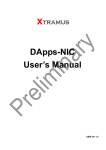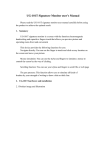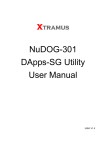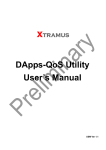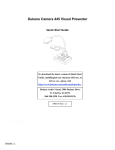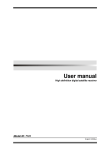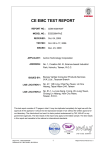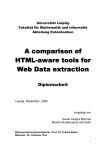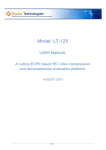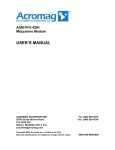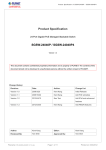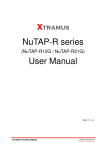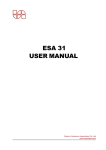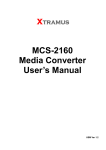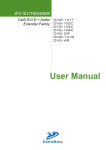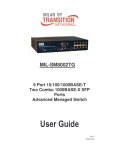Download DApps-2544 User`s Manual
Transcript
DApps-2544 User’s Manual USM Ver 1.1 Foreword Copyright Copyright © 2012 Xtramus Technologies, all rights reserved. The information contained in this document is the property of Xtramus Technologies. No part of this publication shall be reproduced, stored in a retrieval system, or transmitted, in any form or by any means, without the prior written permission of Xtramus Technologies. Disclaimer The information contained in this document is subject to change without notice and does not represent a commitment on the part of Xtramus Technologies. The information in this document is believed to be accurate and reliable. However, Xtramus Technologies assumes no responsibility or liability for any errors or inaccuracies that may appear in the document. Trademarks DApps-2544 is a trademark or registered trademark of Xtramus Technologies. All other trademarks and registered trademarks are the property of their respective owners. Warranty Xtramus Technologies warrants for the hardware provided along with this document under proper usage and conditions in normal environment; any improper operation or in irregular environment may possibly cause this product NOT function well. For detailed terms, please contact your local dealer. Contact Information Xtramus Technologies E-mail: [email protected] Website: www.xtramus.com Tel: +886-2-8227-6611 Fax: +886-2-8227-6622 XTRAMUS TECHNOLOGIES® 2 E-mail: [email protected] Website: www.Xtramus.com Revision History Date 2011/05/03 Version 1.0 2012/07/30 1.1 XTRAMUS TECHNOLOGIES® History First draft version 1. Add NuDOG-801’s descriptions. (Page 5, 28, 31, 34) 2. Renew NuDOG-301C/101T/801’s descriptions. (Page 6-20) 3. Modify NuDOG-301C’s figures. (Page 27, 29, 30, 42) 4. Modify figures for Port Configuration. (Page 38) 5. Modify figures for Test Configuration. (Page 41) 6. Modify figures for Report. (Page 52) 3 E-mail: [email protected] Website: www.Xtramus.com Table of Contents Foreword ..........................................................................................................................................2 Revision History ..............................................................................................................................3 1. General Descriptions of NuDOG-301C ......................................................................................5 2. NuDOG-301C Description ...........................................................................................................6 2.1. NuDOG-301C Overview......................................................................................................6 2.2. Features & Advantages of NuDOG-301C..........................................................................7 2.3. NuDOG-301C Applications in Different Modes ................................................................7 2.4. NuDOG-301C Interface Ports.............................................................................................9 2.5. NuDOG-301C LED Status.................................................................................................10 3. NuDOG-801 Descriptions.......................................................................................................... 11 3.1. NuDOG-801 OVERVIEW ................................................................................................... 11 3.2. Features & Advantages of NuDOG-801 ..........................................................................12 3.3. NuDOG-801 Applications in Different Modes.................................................................12 3.4. NuDOG-801 Interface Ports .............................................................................................14 3.5. NuDOG-801 LED Status ...................................................................................................15 4. NuDOG-101T Descriptions .......................................................................................................16 4.1. NuDOG-101T OVERVIEW .................................................................................................16 4.2. Features & Advantages of NuDOG-101T ........................................................................17 4.3. NuDOG-101T Applications in Different Modes ..............................................................17 4.4. NuDOG-101T Interface Ports ...........................................................................................19 4.5. NuDOG-101T LED Status .................................................................................................20 5. Software Installation and Uninstallation for DApps-2544 ......................................................21 6. DApps-2544 Overview...............................................................................................................27 6.1. Hardware Installation .......................................................................................................27 6.2. Starting DApps-2544.........................................................................................................27 6.3. DApps-2544 Test Modes & Hardware Installation Examples........................................29 6.4. DApps-2544/NuServer Main Window Overview .............................................................31 6.5. Menu Bar ...........................................................................................................................32 6.5.1. File ................................................................................................................................32 6.5.2. View ..............................................................................................................................32 6.5.3. Language......................................................................................................................33 6.5.4. Help...............................................................................................................................33 6.6. Tool Bar .............................................................................................................................34 6.7. System Info/Configuration List .......................................................................................35 6.8. Elapsed Time.....................................................................................................................36 6.9. Description........................................................................................................................37 6.10. Status Bar........................................................................................................................37 6.11. Control Buttons/Test Running Status Icon...................................................................37 7. Port Configuration and Test Configuration.............................................................................38 7.1. Port Configuration............................................................................................................38 7.2. Test Configuration ............................................................................................................41 7.2.1. Test Configuration Overview ......................................................................................43 7.2.2. Throughput Test ..........................................................................................................44 7.2.3. Latency Test .................................................................................................................46 7.2.4. Packet Loss Test .........................................................................................................48 7.2.5. Back to Back Test ........................................................................................................50 7.3. Report ................................................................................................................................52 8. Appendix – Other Utility Softwares for NuDOG series ..........................................................55 XTRAMUS TECHNOLOGIES® 4 E-mail: [email protected] Website: www.Xtramus.com 1. General Descriptions of NuDOG-301C DApps-2544 is a user-friendly and automatic test suite based on industry-standard RFC-2544. It generates and analyzes packets to evaluate the Throughput performances, Latency, Packet Loss, and Back-to-Back of Ethernet switches or routers via this device. The real-time test results display and customized report provides an effective way when examining the DUT. Devices Supporting DApps-2544 NuDOG-301C NuDOG-801 NuDOG-101T Also, please make sure that your PC meets the requirements listed in the table down below before installing DApps-2544. OS CPU RAM HDD Windows 2000/XP Windows Vista/7 Pentium 1.3 GHz or higher 512MB RAM 1GB RAM 10GB of available hard disk space *Note: Large amount of data will be generated while running DApps-2544. It is recommended to preserve enough available Hard-Disk space to store these data. Please see the sections down below for detailed information regarding to NuDOG-301C, NuDOG-801, and NuDOG-101T. XTRAMUS TECHNOLOGIES® 5 E-mail: [email protected] Website: www.Xtramus.com 2. NuDOG-301C Description 2.1. NuDOG-301C Overview NuDOG-301C is a handheld device with two Gigabit ports for Ethernet testing. The main functions of NuDOG-301C include multi-streams generation, TAP/Loopback test, and NIC emulation. Connecting NuDOG-301C to its mini-USB port makes it possible for system configurations and managements. NuDOG-301C is an ideal device for in-field testing. NuDOG-301C can work along with a series of utility software that qualify industrial standards such as RFC 2544, RFC 2889, and QoS. With these utilities, NuDOG-301C is able to conduct throughput test, latency test, error filtering test, forwarding test, and so on. Utility software can provide a user-friendly interface for different test configurations when setting test parameters and criteria. More optional software is available for extended test requirements. With its unique Universal Stream Counter (USC), NuDOG-301C offers real-time statistics of network events during packet monitoring and capturing. With these advantageous features, NuDOG-301C is your best partner for LAB researching and in-field troubleshooting. XTRAMUS TECHNOLOGIES® 6 E-mail: [email protected] Website: www.Xtramus.com 2.2. Features & Advantages of NuDOG-301C ¾ Hardware based wirespeed streams generation, analysis, network TAP and NIC ¾ High precision performance for measuring throughput, latency, packet loss and disordered sequence ¾ Wirespeed traffic capturing with programmable filter and trigger criteria ¾ Supports Universal Stream Counter (USC) with 128 streams ¾ RFC 2544 test suite ¾ RFC 2889 test suite ¾ Layer 1 and Layer 2 loopback test ¾ High precision 1 ppm temperature-compensated oscillator provides accurate clock speed to ensure the reliability of the tests ¾ Adding errors in transmitted traffic to simulate and test abnormal situations ¾ Real-time statistics for each port, including transmitted/received frame for VLAN, IPv4, IPv4 fragment, IPv4 extension , ICMP, ARP, total bytes/packets, CRC, IPCS error and over-and-under size frames ¾ Utility software with user-friendly interface that supports various parameter configurations and meets various test requirements ¾ 512Mbits wirespeed packet capture buffer per port 2.3. NuDOG-301C Applications in Different Modes Stream Generation Mode In Streams Generation mode, NuDOG-301C generates bi-directional network streams for test requirements as the illustration above. Both NuDOG-301C's Port A and Port B can generate and receive test streams. The test streams are sent and returned to the same NuDOG-301C for DUT (device under test) analysis. XTRAMUS TECHNOLOGIES® 7 E-mail: [email protected] Website: www.Xtramus.com TAP/Loopback Mode TAP Mode Loopback Mode In TAP mode, NuDOG-301C can monitor any data that flows through it. Network TAP is a method of monitoring network’s situation dynamically without interference. NuDOG-301C can tap bi-directional or uni-directional traffic from different sides (port A and port B) and also provides abundant packet counters. In Loopback mode, NuDOG-301C resends the incoming streams back to the source. NIC Mode In this mode, NuDOG-301C simulates network interface card (NIC). XTRAMUS TECHNOLOGIES® 8 E-mail: [email protected] Website: www.Xtramus.com 2.4. NuDOG-301C Interface Ports NuDOG-301C Hardware Overview LEDs that displays NuDOG-301C’s status. A LEDs 5 Pin Mini-B Receptacle USB Port. You can manage, configure, or update firmware/FPGA when connecting NuDOG-301C to your PC. B Mini-USB Port* While under TAP mode, this mini-USB port can also re-direct tapped packets to PC. 12V DC Power Jack for connecting external power adapter. C Power Jack Fan hole with internal fan for ventilation. D Cooling FAN E Diagnostic Port 8-Pin Mini-DIN Receptacle Diagnostic Port F Port B - SFP Port 1000 Mbps Full Duplex SFP Port B Only one port can be G Port B - RJ45 Port 10/100/1000 Mbps Half/Full RJ45 Port B used at the same time. H Port A - SFP Port 1000 Mbps Full Duplex SFP Port A Only one port can be I Port A - RJ45 Port 10/100/1000 Mbps Half/Full RJ45 Port A used at the same time. *Please note that when connecting NuDOG-301C with PC via its USB port, DO NOT use a USB hub XTRAMUS TECHNOLOGIES® 9 E-mail: [email protected] Website: www.Xtramus.com 2.5. NuDOG-301C LED Status LED Status Green Blinking Power/Fail Yellow Blinking USB Green Blinking Green SG/TAP Yellow OFF Capture A/B Green Green ON Link/ACT Green Blinking Green ON Speed Green Blinking OFF XTRAMUS TECHNOLOGIES® Description Power is ON and working properly System failed USB of this device is linked to PC NuDOG-301C is working under Stream Generation Mode NuDOG-301C is working under TAP Mode NuDOG-301C is working under NIC (Network Interface Card) mode Port A/B is under Capturing Mode The RJ45 Port is connected to DUT/Network NuDOG-301C is transmitting or receiving data 1000Mbps connection 100Mbps connection 10Mbps connection if Link/ACT is ON or blinking 10 E-mail: [email protected] Website: www.Xtramus.com 3. NuDOG-801 Descriptions 3.1. NuDOG-801 OVERVIEW NuDOG-801 is a handheld device with two 10 Gigabit SFP+ Ports for Ethernet testing. The main functions of NuDOG-801 include multi-streams generation and NIC emulation. Connecting NuDOG-801 to its Standard-B Receptacle USB Port makes it possible for system configurations and managements. NuDOG-801 is an ideal device for in-field testing. NuDOG-801 can work along with a series of utility software that qualify industrial standards such as RFC 2544, RFC 2889, and QoS. With these utilities, NuDOG-801 is able to conduct throughput test, latency test, error filtering test, forwarding test, and so on. Xtramus’ utility software provides a user-friendly interface for different test configurations when setting test parameters and criteria. More optional software is available for extended test requirements. With its unique Universal Stream Counter (USC), NuDOG-801 offers real-time statistics of network events during packet monitoring and capturing. With these advantageous features, NuDOG-801 is your best partner for LAB researching and in-field troubleshooting. XTRAMUS TECHNOLOGIES® 11 E-mail: [email protected] Website: www.Xtramus.com 3.2. Features & Advantages of NuDOG-801 ¾ Hardware based wirespeed streams generation, analysis, and NIC ¾ High precision performance for measuring throughput, latency, packet loss and disordered sequence ¾ Wirespeed traffic capturing with programmable filter and trigger criteria ¾ Supports Universal Stream Counter (USC) with 256 streams ¾ RFC 2544 test suite ¾ RFC 2889 test suite ¾ High precision 1 ppm temperature-compensated oscillator provides accurate clock speed to ensure the reliability of the tests ¾ Adding errors in transmitted traffic to simulate and test abnormal situations ¾ Real-time statistics for each port, including transmitted/received frame for VLAN, IPv4, IPv4 fragment, IPv4 extension , ICMP, ARP, total bytes/packets, CRC, IPCS error and over-and-under size frames ¾ Supports IPv6 ¾ Utility software with user-friendly interface that supports various parameter configurations and meets various test requirements ¾ 32 Capture Blocks for each Test Port 3.3. NuDOG-801 Applications in Different Modes Stream Generation Mode In Streams Generation mode, NuDOG-801 generates bi-directional network streams for test requirements as the illustration above. Both NuDOG-801’s Port A and Port B can generate and receive test streams. The test streams are sent and returned to the same NuDOG-801 for DUT (device under test) analysis. XTRAMUS TECHNOLOGIES® 12 E-mail: [email protected] Website: www.Xtramus.com TAP/Loopback Mode TAP Mode Loopback Mode In TAP mode, NuDOG-801 can monitor any data that flows through it. Network TAP is a method of monitoring network’s situation dynamically without interference. NuDOG-801 can tap bi-directional or uni-directional traffic from different sides (port A and port B) and also provides abundant packet counters. In Loopback mode, NuDOG-801 resends the incoming streams back to the source. NIC Mode In this mode, NuDOG-801 simulates network interface card (NIC). XTRAMUS TECHNOLOGIES® 13 E-mail: [email protected] Website: www.Xtramus.com 3.4. NuDOG-801 Interface Ports NuDOG-801C Hardware Overview LEDs that displays NuDOG-801C’s status. A LEDs 5 Pin Mini-B Receptacle USB Port. You can manage, configure, or update firmware/FPGA when connecting NuDOG-801C to B Mini-USB Port* your PC. While under TAP mode, this mini-USB port can also re-direct tapped packets to PC. 12V DC Power Jack for connecting external power adapter. C Power Jack Fan hole with internal fan for ventilation. D Cooling FAN 8-Pin Mini-DIN Receptacle Diagnostic Port E Diagnostic Port 10 Gigabit Wirespeed 10 Gigabit Wirespeed SFP+ Port F SFP+ Port *Please note that when connecting NuDOG-801C with PC via its USB port, DO NOT use a USB hub XTRAMUS TECHNOLOGIES® 14 E-mail: [email protected] Website: www.Xtramus.com 3.5. NuDOG-801 LED Status LED Status Green Blinking Power/Fail Yellow Blinking USB Green Blinking Yellow Blinking Error/Loss OFF Capture A/B Green Green ON Link/ACT Green Blinking XTRAMUS TECHNOLOGIES® Description Power is ON and working properly System failed USB of this device is linked to PC CRC error or packet loss is occurring No CRC error or packet loss is occurring Port A/B is under Capturing Mode The RJ45 Port is connected to DUT/Network NuDOG-801 is transmitting or receiving data 15 E-mail: [email protected] Website: www.Xtramus.com 4. NuDOG-101T Descriptions 4.1. NuDOG-101T OVERVIEW NuDOG-101T is a handheld device with two ports for Ethernet testing. The main functions of NuDOG-101T include multi-streams generation, TAP/Loopback test, and NIC emulation. Connecting NuDOG-101T to its mini-USB port makes it possible for system configurations and managements. NuDOG-101T is an ideal device for in-field testing. NuDOG-101T can work along with a series of utility software that qualify industrial standards such as RFC 2544, RFC 2889, and QoS. With these utilities, NuDOG-101T is able to conduct throughput test, latency test, error filtering test, forwarding test, and so on. The utility software provides a user-friendly interface for making different test configurations and setting test parameters and criteria. More optional software is available for extended test requirements. With its unique Universal Stream Counter (USC), NuDOG-101T offers real-time statistics of network events during packet monitoring and capturing. With these advantageous features, NuDOG-101T is your best partner for LAB researching and in-field troubleshooting. XTRAMUS TECHNOLOGIES® 16 E-mail: [email protected] Website: www.Xtramus.com 4.2. Features & Advantages of NuDOG-101T ¾ Hardware based wirespeed streams generation, analysis, network TAP and NIC ¾ High precision performance for measuring throughput, latency, packet loss and disordered sequence ¾ Wirespeed traffic capturing with programmable filter and trigger criteria ¾ Supports Universal Stream Counter (USC) with 128 streams ¾ RFC 2544 test suite ¾ RFC 2889 test suite ¾ Layer 1 and Layer 2 loopback test ¾ High precision 1 ppm temperature-compensated oscillator provides accurate clock speed to ensure the reliability of the tests ¾ Injecting errors in transmitted traffic to simulate and test abnormal situations ¾ Real-time statistics for each port, including transmitted /received frame for VLAN, IPv4, IPv4 fragment, IPv4 extension , ICMP, ARP, total bytes/packets, CRC, IPCS error and over-and-under size frames ¾ User-friendly interface that supports various parameter configurations and meets various test requirements ¾ 256Mbits packet capture buffer per port 4.3. NuDOG-101T Applications in Different Modes Stream Generation Mode In Streams Generation mode, NuDOG-101T generates bi-directional network streams for test requirements as the illustration above. Both NuDOG-101T’s Port A and Port B can generate and receive test streams. The test streams are sent and returned to the same NuDOG-101T for DUT (device under test) analysis. XTRAMUS TECHNOLOGIES® 17 E-mail: [email protected] Website: www.Xtramus.com TAP/Loopback Mode TAP Mode Loopback Mode In TAP mode, NuDOG-101T can monitor any data that flows through it. Network TAP is a method of monitoring network’s situation dynamically without interference. NuDOG-101T can tap bi-directional or uni-directional traffic from different sides (port A and port B) and also provides abundant packet counters. In Loopback mode, NuDOG-101T resends the incoming streams back to the source. NIC Mode In this mode, NuDOG-101T simulates network interface card (NIC). XTRAMUS TECHNOLOGIES® 18 E-mail: [email protected] Website: www.Xtramus.com 4.4. NuDOG-101T Interface Ports NuDOG-101T Hardware Overview A Mini-USB Port for connecting NuDOG-101T to PC or for power supply. B LEDs that display NuDOG-101T’s system status. C Interface Port A/B for connecting NuDOG-101T to DUT or network. XTRAMUS TECHNOLOGIES® 19 E-mail: [email protected] Website: www.Xtramus.com 4.5. NuDOG-101T LED Status LED Status Green Blinking Power Yellow Blinking USB Green Blinking Green PG/TAP Yellow OFF Capture A/B Green Green ON Link/ACT Green Blinking Green ON Speed Green Blinking OFF XTRAMUS TECHNOLOGIES® Description Power is ON and working properly System failed USB of this device is linked to PC NuDOG-101T is working under Packet Generation Mode NuDOG-101T is working under TAP Mode NuDOG-101T is working under NIC (Network Interface Card) mode Port A/B is under Capturing Mode The RJ45 Port is connected to DUT/Network NuDOG-101T is transmitting or receiving data 1000Mbps connection 100Mbps connection 10Mbps connection if Link/ACT is ON or blinking 20 E-mail: [email protected] Website: www.Xtramus.com 5. Software Installation and Uninstallation for DApps-2544 Please follow the steps down below to install DApps-2544: Installing DApps-2544 XTRAMUS TECHNOLOGIES® 21 1. Double-click DApps-2544 installation program and start the installation process. 2. InstallShield Wizard is starting to install DApps-2544. If you would like to cancel installation, click “Cancel”. 3. Click “Next” to continue installation. E-mail: [email protected] Website: www.Xtramus.com Installing DApps-2544 XTRAMUS TECHNOLOGIES® 22 4. Click “I accept the terms in the license agreement”, and click “Next” to continue. 5. You can set your User Name and Organization here, and click “Next” to continue. 6. You can select the Complete option to install all program feature for running DApps-2544, or select Custom option to choose the program feature to be installed. E-mail: [email protected] Website: www.Xtramus.com Installing DApps-2544 7. DApps-2544 InstallShield Wizard will start installing momentarily. Click Install button if the information is correct. 8. InstallShield Wizard is installing DApps-2544. 9. XTRAMUS TECHNOLOGIES® 23 DApps-2544 installation completes. Click Finish button to exit. E-mail: [email protected] Website: www.Xtramus.com Installing DApps-2544 10. WinPcap Installer appears. Click Next button to get ready to install, or click Cancel button to stop. 11. WinPcap is preparing to install, or click Cancel button to stop at any time. 12. Review the license agreement before installing. Click I Agree button to continue. It is necessary to accept the agreement to install WinPcap. XTRAMUS TECHNOLOGIES® 24 E-mail: [email protected] Website: www.Xtramus.com Installing DApps-2544 13. WinPcap is installing. 14. WinPcap installation completes. Click Finish button to close the wizard. XTRAMUS TECHNOLOGIES® 25 E-mail: [email protected] Website: www.Xtramus.com You can uninstall DApps-2544 by: XTRAMUS TECHNOLOGIES® 26 ¾ Click Start → Programs → Xtramus → DApps-2544 → Uninstall DApps-2544 ¾ Go to the Control Panel, choose DApps-2544 from installed program list, and click “Remove” to uninstall as well. E-mail: [email protected] Website: www.Xtramus.com 6. DApps-2544 Overview 6.1. Hardware Installation Before starting DApps-2544, your PC and NuDOG-301C/NuDOG-801/NuDOG-101T shall be connected properly. The figure down below illustrates connecting PC and NuDOG-301C. You can connect NuDOG-801 and NuDOG-101T with PC in the same manner. 6.2. Starting DApps-2544 Before starting DApps-2544, the DUT, your PC, and NuDOG-301C/801/101T shall be connected as shown in “6.1. Hardware Installation”. You can start running DApps-2544 by: XTRAMUS TECHNOLOGIES® 27 ¾ Click Start Æ Programs Æ NuStreams Æ DApps-2544. ¾ Double-click DApps-2544 icon located on your PC’s desktop. E-mail: [email protected] Website: www.Xtramus.com If your PC is not connected with NuDOG-101T/801/301C, you can still run DApps-2544 under Demo mode. Almost all DApps-2544’s functions are available under Demo Mode. However, please note that Demo Mode is for system demo purposes only, and does not serve any testing purposes at all. XTRAMUS TECHNOLOGIES® 28 E-mail: [email protected] Website: www.Xtramus.com 6.3. DApps-2544 Test Modes & Hardware Installation Examples After starting DApps-2544 as mentioned in the above section, a “Connect to NuDOG” window will pop up. DApps-2544 supports 3 different test modes: NuDOG Only Mode, End-to-end Mode, and Round-trip Mode. Please see the section down below for more information and hardware installation examples regarding to these test modes. NuDOG Only Mode Under "NuDOG Only" mode, DUT is connected to NuDOG-301C, which generates packets and sends them to the DUT for testing. XTRAMUS TECHNOLOGIES® 29 E-mail: [email protected] Website: www.Xtramus.com End-to-end Mode Under "End-to-end" mode, DUT is connected between NuDOG-301C and LB-300. Test packets are sent between NuDOG-301C and LB-300 in a one-way direction, while the DUT serves as the middle point. Round-trip Mode Under "Round-trip" mode, DUT is connected between NuDOG-301C and LB-300. Test packets are sent between NuDOG-301C and LB-300 in a loop-back manner, while the DUT serves as the middle point. XTRAMUS TECHNOLOGIES® 30 E-mail: [email protected] Website: www.Xtramus.com 6.4. DApps-2544/NuServer Main Window Overview DApps-2544 Main Window DApps-2544 Functions Overview The Menu Bar allows you to load/save settings, show or hide the Tool A Menu Bar Bar/Status Bar, change language displayed, view the version of the software/NuDOG-301C/801/101T and system requirement. The Tool Bar allows you to reconnect your PC to your NuDOG-301C/801/101T, save the configuration, save and show the test report, and configure the B Tool Bar port/test settings. By clicking the System Info/Configuration List, you can view system System C Info/Configuration information, making port/test configurations, or view test reports on H. Main Display Screen. List D Elapsed Time E Description The Elapsed Time field displays the elapsed time during test. The Description field display brief descriptions regarding to tests. The Status Bar shows the DApps-2544’s running status. Status Bar Control Buttons/Test The Control Buttons allow you to start/stop tests, and the Test Running G Running Status Icon Status Icon indicates if there’s a test running. You can make detail configurations and view real-time testing diagrams on the H Counter Window Main Display Screen. System Connection This icon shows the connection status between your PC and I NuDOG-301C/801/101T. Status F XTRAMUS TECHNOLOGIES® 31 E-mail: [email protected] Website: www.Xtramus.com 6.5. Menu Bar DApps-2544 Menu Bar includes configuration options such as File, View, Languages, and Help. Please refer to the sections down below for detail information regarding to each configuration option. 6.5.1. File File If you have a previously saved configuration setting file stored in your PC, you can load it and apply all the setting you’ve made by choosing Load default configuration. All configuration files are saved in the format of “*.xml”. The Save current configuration function on the Menu Bar allows you to save the Save current settings you’ve made. configuration Configuration files are saved in the format of “*.xml”. To save the test results, choose Set Report Save Path to… from the Menu Bar after performing test, and choose the file path where you would like to save your test Set Report Save results. Test results and related statistic are available and can be viewed with the Path to… “*.xls” file you saved this way. Please note that you need Microsoft Excel® to view “*.xls” file. A prompt pop-up window will ask if you are sure to exit DApps-2544. Click YES to Exit exit DApps-2544, or click NO to cancel. Load default configuration 6.5.2. View View Selecting this option will allow you to show or hide the Tool Bar. Toolbar Status Bar Selecting this option will allow you to show or hide the Status Bar. XTRAMUS TECHNOLOGIES® 32 E-mail: [email protected] Website: www.Xtramus.com 6.5.3. Language Language English/ Chinese Simplified DApps-2544 has 2 different languages for its UI available. You can set the language of UI to either English and Simplified Chinese. 6.5.4. Help Help An “About” window will pop up and show detailed system information. About… Click the OK button to exit the “About DApps-2544” pop-up window. A “System Requirements” window will pop up and show the requirements for your PC and the FPGA/Firmware of the module. System Requirements XTRAMUS TECHNOLOGIES® Click the OK button to exit the “System Requirements” pop-up window. 33 E-mail: [email protected] Website: www.Xtramus.com 6.6. Tool Bar The Tool Bar allows you to load/save configuration, save report, configure port/test settings, reconnect the NuDOG-301C/NuDOG-801/NuDOG-101T to your PC and see test report. Tool Bar If the USB connection between your PC and NuDOG-301C/NuDOG-801/NuDOG-101T is down, a “Disconnected” icon will be shown in “System Connection Status”. to re-establish the connection between your PC and Press Reconnect button NuDOG-301C/NuDOG-801/NuDOG-101T. If the connection has been established successfully, a message window will pop up, and the “System Connection Status” will be shown as “Connected” . If you have a previously saved configuration setting file stored in your PC, you can load it and apply all the setting you’ve made by clicking the “Open” button on the Tool Bar. All configuration files are saved in the format of “*.xml” The Save Config button on the Tool Bar allows you to save the settings you’ve made or the test results. Configuration files are saved in the format of “*.xml”. The Save Report button on the Tool Bar allow you to save the test results. To save the test results, click the “Save” button on the Tool Bar after performing tests, and choose the file path where you would like to save your test results. By default, these test results are named with a prefix of “RFC 2544TestResult”, and following by the date/time when the file are created. Test results and related statistic are available and can be viewed with the “*.xls” file you saved this way. Please note that you need Microsoft Excel® to view “*.xls” file. By clicking the Port Config button, the Port Configuration screen will be shown on the Main Display Screen located on the right side of DApps-2544’s main window, allowing you to make settings for NuDOG-301C/NuDOG-801/NuDOG-101T’s ports. Settings such as port transmitting rate, auto-negotiation, and protocol are available and can be set here. For more detail description about Port Configuration, please refer to 7.1. Port Configuration. By clicking the Test Config button, the Test Configuration screen will be shown on the Main Display Screen located on the right side of DApps-2544’s main window, allowing you to make test settings. You can set 4 different test modes here, including Throughput, Latency, Packet Loss and Back to Back. For more detail description about Test Configuration, please refer to 7.2. Test Configuration. Clicking this button will show the test result on the Main Screen. XTRAMUS TECHNOLOGIES® 34 E-mail: [email protected] Website: www.Xtramus.com 6.7. System Info/Configuration List The System Info/Configuration List allows you to view system information, making port/test configurations, and check test reports on the Main Display Screen. System Information By clicking the System Information on the System Info/Configuration List, the System Information screen will be shown on the Main Display Screen located on the right side of DApps-2544’s main window. Port Config By clicking the Port Config on the System Info/Configuration List, the Port Configuration screen will be shown on the Main Display Screen located on the right side of DApps-2544’s main window, allowing you to make settings for NuDOG-301C’s ports. Settings such as port transmitting rate, auto-negotiation, and protocol are available and can be set here. For more detail description please refer to 7.1. Port Configuration. XTRAMUS TECHNOLOGIES® 35 E-mail: [email protected] Website: www.Xtramus.com Test Config (Throughput, Latency, Packet Loss, Back to Back) By clicking the Test Config on the System Info/Configuration List, the Test Configuration screen will be shown on the Main Display Screen located on the right side of DApps-2544’s main window, allowing you to make test settings. You can set 4 different test modes here, including Throughput, Latency, Packet Loss, and Back to Back. For more detail description, please refer to 7.2. Test Configuration. Report The Report on the System Info/Configuration List allows you to view test results, charts, and statistics on the Main Display Screen located on the right side of DApps-2544’s main window. For more detail description about Report, please refer to 7.3. Report. 6.8. Elapsed Time The Elapsed Time allows you to know the time spent during tests. XTRAMUS TECHNOLOGIES® 36 E-mail: [email protected] Website: www.Xtramus.com 6.9. Description The Description displays brief descriptions and figures regarding to Throughput, Latency, Packet Loss, and Back to Back tests. 6.10. Status Bar The Status Bar shows the running status of DApps-2544. 6.11. Control Buttons/Test Running Status Icon The Control Buttons allow you to start/stop tests, and the Test Running Status Icon indicates if there’s a test running. Control Buttons Start test Stop test Test Running Status Icon No test is underway Test is running XTRAMUS TECHNOLOGIES® 37 E-mail: [email protected] Website: www.Xtramus.com 7. Port Configuration and Test Configuration 7.1. Port Configuration Settings such as port transmitting rate, auto-negotiation, and protocol are available and can be configured on the Port Configuration displayed on the Main Display Screen. There are two ways to access Port Config: Accessing Port Config • Click Port Config located on System Info/ Configuration List • Click the Port Config button located on Tool Bar. The Port Configuration contains two different sets of settings: Port and Protocol. These two settings can be accessed by clicking the Port or Protocol menu tab. ¾ Port: Allows you to set each port’s transmitting rate, flow control, and auto-negotiation. ¾ Protocol: Allows you to set each port’s protocol (Layer 2 or Layer 3-IP), VLAN, and IP addresses. XTRAMUS TECHNOLOGIES® 38 E-mail: [email protected] Website: www.Xtramus.com Port ¾ Port No: This field lists NuDOG-301C’s Test Port (Port A/B). ¾ Card Type: This field lists the model name of the test device. ¾ Speed: The Speed scroll-down menu allows you to set each port’s transmitting/receiving rate. ¾ Duplex: You can set the port as Full-Duplex or Half-Duplex with the scroll-down menu. ¾ Flow Control: When enabling this function, the transmitting rate will drop if traffic overflow occurs. ¾ Auto Negotiate: By clicking the scroll-down menu, you can set the transmitting mode to Auto (with auto-negotiation) or Force (without auto-negotiation). ¾ Media Waiting Time: The minimum waiting time (in seconds) for auto-negotiation. ¾ Media Timeout: If the time (in seconds) DApps-2544 spent for auto-negotiation exceeds the time you set here, the test will stop. XTRAMUS TECHNOLOGIES® 39 E-mail: [email protected] Website: www.Xtramus.com Protocol ¾ Port No.: This field displays each port’s Port ID. ¾ Protocol: The Protocol shows each port’s protocol. • Layer 2: Packets will be transmitted and received via layer 2 MAC addresses. • Layer 3-IP: Packets will be transmitted and received via layer 3 IP addresses. ¾ Port MAC: These fields display the Source/Destination MAC addresses. ¾ Enable VLAN: Enable or Disable VLAN function. ¾ VID: You can set the VID in this field. ¾ CFI: Enable or Disable the CID in this field. ¾ Priority: Set the value of priority in this field. ¾ Port IP: You can modify the port IP in this field. ¾ Gateway IP: You can modify the gateway IP address in this field. ¾ IP Mask: You can modify the IP Mask in this field. ¾ Min Waiting Time: The minimum waiting time (in seconds) for auto-negotiation. ¾ Media Timeout: If the time (in seconds) DApps-2544 spent for auto-negotiation exceeds the time you set here, the test will stop. XTRAMUS TECHNOLOGIES® 40 E-mail: [email protected] Website: www.Xtramus.com 7.2. Test Configuration 4 different test modes, including Throughput, Latency, Packet Loss, and Back to Back, can be configured on the Test Configuration displayed on the Main Display Screen. There are two ways to access Test Config: Accessing Test Config • Click Test Config located on System Info/ Configuration List • Click the Test Config button located on Tool Bar. The Test Configuration contains four different sets of settings: Throughput, Latency, Packet Loss and Back to Back, which can be accessed by clicking the test you would like to perform on System Info/Configuration List or the tab menu located on Test Configuration screen. XTRAMUS TECHNOLOGIES® 41 E-mail: [email protected] Website: www.Xtramus.com Assigning Source Port and Destination Port for DApps-2544 Before making any test configurations on the Test Configuration screen, you have to assign the Source Port and Destination Port for DApps-2544 first on the upper part of the Test Configuration menu. If you’ve chosen NuDOG Only as DApps-2544’s test mode, please select whether you would like to use NuDOG-301C’s Port A or Port B as the Source Port or Destination Port as shown in the figure down below. If you’ve chosen End-to-End or Round-Trip as DApps-2544’s test mode, please select whether you would like to use NuDOG-301C’s Port A, Port B, or LB-300 as the Source Port or Destination Port as shown in the figure down below. For more information regarding to DApps-2544’s test modes, please refer to description down below. XTRAMUS TECHNOLOGIES® 42 E-mail: [email protected] Website: www.Xtramus.com 7.2.1. Test Configuration Overview DApps-2544 supports four different tests including: Diagram Description Throughput test determines the DUT’s maximum capable throughput rate without dropping any packets. Latency test measures the time it takes for the DUT to forward a packet. Packet Loss test measures the percentage of packets that are not forwarded due to the lack of resource. Back to Back test measures DUT’s buffer capacity by sending bursts of traffic at the maximum frame rate and measuring the longest burst size without dropping any packets. To start performing tests with DApps-2544, please check the check box in front of the test you would like to perform first. Unchecked tests will not be performed, and you cannot access their reports as well during or after the tests. You can access setting options for the tests you would like to perform by: Accessing Test Setting Pages • Click the test you would like to configure located on System Info/Configuration List • Click the test you would like to configure located on the test tab menu. For more detailed setting options regarding to Throughput, Latency, Packet Loss and Back to Back, please refer to the sections down below. XTRAMUS TECHNOLOGIES® 43 E-mail: [email protected] Website: www.Xtramus.com 7.2.2. Throughput Test Throughput test determines the DUT’s maximum capable throughput rate without dropping any packets. The Throughput configuration page allows you to customize the test duration, packet length, packet transmission rate (%) for the desired testing environment. Duration (Secs) Number of Trials The duration of time (in seconds) for the test. The range for the testing time is 1~5000. The number of times of the test. The range for the number of times of the test is 1~100. Load Percentage (%) The starting network traffic rate (%) of the test. Start from Load Percentage Min. The minimum acceptable network traffic rate (%) of the test. The maximum acceptable network traffic rate (%) of the test. Stopping at The test will stop when the difference between the current network traffic rate Resolution and the last network traffic rate is smaller than the value you set here. The acceptable rate of packet loss during the test. Acceptable Loss Frame Size (bytes) Starting from Frame Size Step Stopping at Random The starting/ending size of the transmitted packet. The range of the Starting from/at field is 64~2032. The frame size will increase in arithmetic progression fashion, while the value you set here will serve as its difference. The range of the Frame Size Step is 64~2032. The maximum network frame size (Bytes) of the test. When enabled, DApps-2544 will generate different sizes of frames at random*. * Note: As of May 3rd, 2011, Random Frame Size is not supported yet. XTRAMUS TECHNOLOGIES® 44 E-mail: [email protected] Website: www.Xtramus.com You can customize the size of each transmitted packet manually by enabling Custom function and clicking the Edit button. A Packet Size Customization -Throughput window will pop up. You can customize the Initial Rate, Min/Max Rate, Resolution, and Acceptable Loss here as well. Custom You can double-click the field you would like to customize and input the value manually. • Number of Different Packet Size: You can set how many different frame sizes you would like to apply to the test here in this field. • OK/Cancel: Apply/cancel the changes you’ve made. • Default: Set all the values to default value. This function allows the DUT to create an address table according to the source address in the received frame. Learning Mode Learning Retry Bi-Direction Router Test* Next-Hop Test* • Never: DUT will never create an address table, and Learning Mode is disabled. • Once: DUT will create an address table only once. • Every Trial: DUT will create an address table in every trial. The value set here will be the number of learning packets that will be sent through the ports chosen to be learned for building address table. Enabling this function allows two-way direction transmitting during the test. Enabling this function to perform router (Residential Gateway) tests using Ping/ARP. Some routers (Residential Gateway) have the abilities to simulate as routers with next-hop capability according to RFC-2544. Enable this function if the DUT have such capability. *Note: As of May 3rd, 2011, both Router Test and Next-Hop Test are not supported yet. XTRAMUS TECHNOLOGIES® 45 E-mail: [email protected] Website: www.Xtramus.com 7.2.3. Latency Test Latency test measures the time it takes for the DUT to forward a packet. The load generated by NuDOG-301C can be customized with different packet lengths and for specified period of times. Duration (Secs) Number of Trials The duration of time (in seconds) for the test. The range for the testing time is 1~5000. The number of times of the test. The range for the number of times of the test is 1~100. Load Percentage (%) The starting network traffic rate (%) of the test. Starting from Load Percentage Step The minimum acceptable network traffic rate (%) of the test. The maximum acceptable network traffic rate (%) of the test. Stopping at The test will stop when the difference between the current network traffic rate Resolution and the last network traffic rate is smaller than the value you set here. The acceptable rate of packet loss during the test. Acceptable Loss Frame Size (bytes) Starting from Frame Size Step Stopping at Random The starting/ending size of the transmitted packet. The range of the Starting from/at field is 64~2032. The frame size will increase in arithmetic progression fashion, while the value you set here will serve as its difference. The range of the Frame Size Step is 64~2032. The maximum network frame size (Bytes) of the test. When enabled, DApps-2544 will generate different sizes of frames at random*. * Note: As of May 3rd, 2011, Random Frame Size is not supported yet. XTRAMUS TECHNOLOGIES® 46 E-mail: [email protected] Website: www.Xtramus.com You can customize the size of each transmitted packet manually by enabling Custom function and clicking the Edit button. A Packet Size Customization Latency window will pop up. You can customize the Initial Rate, Step Rate, and Max. Rate here as well. Custom You can double-click the field you would like to customize and input the value manually. • Number of Different Packet Size: You can set how many different frame sizes you would like to apply to the test here in this field. • OK/Cancel: Apply/cancel the changes you’ve made. • Default: Set all the values to default value. This function allows the DUT to create an address table according to the source address in the received frame. Learning Mode Learning Retry Bi-Direction Router Test* Next-Hop Test* • Never: DUT will never create an address table, and Learning Mode is disabled. • Once: DUT will create an address table only once. • Every Trial: DUT will create an address table in every trial. The value set here will be the number of learning packets that will be sent through the ports chosen to be learned for building address table. Enabling this function allows two-way direction transmitting during the test. Enabling this function to perform router (Residential Gateway) tests using Ping/ARP. Some routers (Residential Gateway) have the abilities to simulate as routers with next-hop capability according to RFC-2544. Enable this function if the DUT have such capability. *Note: As of May 3rd, 2011, both Router Test and Next-Hop Test are not supported yet. XTRAMUS TECHNOLOGIES® 47 E-mail: [email protected] Website: www.Xtramus.com 7.2.4. Packet Loss Test Packet Loss test measures the percentage of packets that are not forwarded (therefore, lost) due to the lack of resource. The loading and the testing time can be customized to simulate real-world scenario; thus, giving the user a clear view of DUT’s performance limits under different loading environments. Duration (Secs) Number of Trials The duration of time (in seconds) for the test. The range for the testing time is 1~5000. The number of times of the test. The range for the number of times of the test is 1~100. Load Percentage (%) The starting network traffic rate (%) of the test. Start from Load Percentage Min. The minimum acceptable network traffic rate (%) of the test. The maximum acceptable network traffic rate (%) of the test. Stopping at The test will stop when the difference between the current network traffic rate Resolution and the last network traffic rate is smaller than the value you set here. The acceptable rate of packet loss during the test. Acceptable Loss Frame Size (bytes) Starting from/at Frame Size Step Stopping at Random The starting/ending size of the transmitted packet. The range of the Starting from/at field is 64~2032. The frame size will increase in arithmetic progression fashion, while the value you set here will serve as its difference. The range of the Frame Size Step is 64~2032. The maximum network frame size (Bytes) of the test. When enabled, DApps-2544 will generate different sizes of frames at random*. * Note: As of May 3rd, 2011, Random Frame Size is not supported yet. XTRAMUS TECHNOLOGIES® 48 E-mail: [email protected] Website: www.Xtramus.com You can customize the size of each transmitted packet manually by enabling Custom function and clicking the Edit button. A Packet Size Customization – Packet Loss window will pop up. You can customize the Initial Rate, Step Rate, and Max. Rate here as well. Custom You can double-click the field you would like to customize and input the value manually. • Number of Different Packet Size: You can set how many different frame sizes you would like to apply to the test here in this field. • OK/Cancel: Apply/cancel the changes you’ve made. • Default: Set all the values to default value. This function allows the DUT to create an address table according to the source address in the received frame. Learning Mode Learning Retry Bi-Direction Router Test* Next-Hop Test* • Never: DUT will never create an address table, and Learning Mode is disabled. • Once: DUT will create an address table only once. • Every Trial: DUT will create an address table in every trial. The value set here will be the number of learning packets that will be sent through the ports chosen to be learned for building address table. Enabling this function allows two-way direction transmitting during the test. Enabling this function to perform router (Residential Gateway) tests using Ping/ARP. Some routers (Residential Gateway) have the abilities to simulate as routers with next-hop capability according to RFC-2544. Enable this function if the DUT have such capability. *Note: As of May 3rd, 2011, both Router Test and Next-Hop Test are not supported yet. XTRAMUS TECHNOLOGIES® 49 E-mail: [email protected] Website: www.Xtramus.com 7.2.5. Back to Back Test Back to Back test measures DUT’s buffer capacity by sending bursts of traffic at the maximum frame rate and measuring the longest burst size without dropping any packets. Duration (Secs) Number of Trials The duration of time (in seconds) for the test. The range for the testing time is 1~5000. The number of times of the test. The range for the number of times of the test is 1~100. Load Percentage (%) The starting network traffic rate (%) of the test. Starting from Load Percentage Step The minimum acceptable network traffic rate (%) of the test. The maximum acceptable network traffic rate (%) of the test. Stopping at The test will stop when the difference between the current network traffic rate Resolution and the last network traffic rate is smaller than the value you set here. The acceptable rate of packet loss during the test. Acceptable Loss Frame Size (bytes) Starting from Frame Size Step Stopping at Random* The starting/ending size of the transmitted packet. The range of the Starting from/at field is 64~2032. The frame size will increase in arithmetic progression fashion, while the value you set here will serve as its difference. The range of the Frame Size Step is 64~2032. The maximum network frame size (Bytes) of the test. When enabled, DApps-2544 will generate different sizes of frames at random. *Note: As of May 3rd, 2011, Random Frame Size is not supported yet. XTRAMUS TECHNOLOGIES® 50 E-mail: [email protected] Website: www.Xtramus.com You can customize the size of each transmitted packet manually by enabling Custom function and clicking the Edit button. A Packet Size Customization – Back to Back window will pop up. You can customize the Initial Rate, Step Rate, and Max. Rate here as well. Custom You can double-click the field you would like to customize and input the value manually. • Number of Different Packet Size: You can set how many different frame sizes you would like to apply to the test here in this field. • OK/Cancel: Apply/cancel the changes you’ve made. • Default: Set all the values to default value. This function allows the DUT to create an address table according to the source address in the received frame. • Never: DUT will never create an address table, and Learning Mode is disabled. • Once: DUT will create an address table only once. • Every Trial: DUT will create an address table in every trial. The value set here will be the number of learning packets that will be sent through the ports chosen to be learned for building address table. Enabling this function allows two-way direction transmitting during the test. Enabling this function to perform router (Residential Gateway) tests using Ping/ARP. Some routers (Residential Gateway) have the abilities to simulate as routers with next-hop capability according to RFC-2544. Enable this function if the DUT have such capability. Learning Mode Learning Retry Bi-Direction Router Test* Next-Hop Test* *Note: As of May 3rd, 2011, both Router Test and Next-Hop Test are not supported yet. XTRAMUS TECHNOLOGIES® 51 E-mail: [email protected] Website: www.Xtramus.com 7.3. Report Test results, statistics and charts are displayed and can be checked on the Main Display Screen. There are two ways to view Report: Accessing Report • Click Report located on System Info/ Configuration List. • Click the Report button located on Quick Launch Buttons. During the tests, charts for the results of each test (Throughput, Latency, Packet Loss or Back to Back) will be displayed on the Main Display Screen. DApps-2544 will switch charts of each test automatically when finishing the current test and starting the next test as shown in the figures. Please note that you can only access charts of the tests you’ve performed. XTRAMUS TECHNOLOGIES® 52 E-mail: [email protected] Website: www.Xtramus.com Throughput Test Result Chart This chart uses Frame Count per Second as X-Axis, and Frame Size as Y-Axis to show DUT’s throughput performance. Latency Test Result Chart This chart uses Latency in Microseconds (µs) as X-Axis, and Frame Size/Load as Y-Axis. • Store and Forward: Represents packets that were stored inside DUT’s buffer before transmitted. • Cut Through: Represents packets that were Packet Loss Test Result Chart transmitted right away. Back to Back Test Result Chart This chart uses Packet Loss Rate (%) as X-Axis, and Frame Size/Load as Y-Axis to show DUT’s packet loss ratio. This chart uses Pass Frame Count as X-Axis, and Frame Size/Load as Y-Axis to show DUT’s back to back test result. To view detail statistics on the chart, please move the mouse cursor to the part you would like to know more, as shown in the figure on the left. XTRAMUS TECHNOLOGIES® 53 E-mail: [email protected] Website: www.Xtramus.com Also, you can view test results counter by clicking the Counter tab menu. All statistics will be displayed in this table in great detail for test result analysis. You can save the test results by: Saving Test Results • Click Save located on Menu Bar. • Click the Save button located on Tool Bar. Test results and related statistic are available and can be viewed with the “*.xls” file you saved this way. You need Microsoft Excel® to view “*.xls” file. XTRAMUS TECHNOLOGIES® 54 E-mail: [email protected] Website: www.Xtramus.com 8. Appendix – Other Utility Softwares for NuDOG series There are several other optional utility softwares for NuDOG-301C/NuDOG-801/NuDOG-101T for different kinds of test requirements. The following section contains brief descriptions of these utility softwares. DApps-TAP: Network TAP/Loopback Utility For NuDOG-301C/NuDOG-801/NuDOG-101T, all data streams between two network ports can be duplicated and sent to PC via mini USB port for monitoring and analyzing. The user can specify conditions to filter the packets wanted with DApps-TAP application software. It reduces USB port’s network traffic and also cuts down PC resource consumption while dealing with large quantity of packets. DApps-SG: Control Suite for Multiple Streams Generator DApps-SG provides a powerful and sophisticated virtual front control panel to manage this device. Two test ports can be configured independently with parameters to define multiple streams and capture capabilities. Traffic for various network protocols can be customized, transmitted, and received on each port. Comprehensive statistics give users an in-depth analysis of the DUT performance. DApps-NIC: Network Interface Card Simulation Suite NuDOG-301C/NuDOG-801/NuDOG-101T has a mini-USB port for PC connection. In addition to network TAP, system control and system upgrade functions. NuDOG-301C/NuDOG-801/NuDOG-101T can also be used as a network interface card. With control software and NuDOG-301/NuDOG-801/NuDOG-101T’s hardware conversion, network data streams can flow between NuDOG-301C/NuDOG-801/NuDOG-101T’s USB and network port. DApps-2544: Test Suit Based on RFC 2544 DApps-2544 is a user-friendly and automatic test suite based on industry-standard RFC 2544. It generates and analyzes packets to evaluate the Throughput performances, Latency, Packet Loss, and Back-to-Back of Ethernet switches or routers via this device. The real-time test results display and customized report provide an effective way when examining the DUT. DApps-2889: Test Suit Based on RFC 2889 DApps-2889 is a user-friendly and automatic test suite based on industry-standard RFC 2889 (partial) to test the DUT. RFC 2889 provides methodology for benchmarking for local area network (LAN) switching devices, forwarding performance, congestion control, latency, address handling and filtering. It extends the methodology already defined for benchmarking network interconnecting devices in RFC 2889. DApps-MPT: Automatic batch tests for Ethernet device DApps-MPT is an accurate and efficient software suite for mass-production scale test or batch network test. Various packet generation and reception testing items could be configured to pre-defined testing modes. The utility of DApps-MPT can load testing models easily. All simple and visualized results and detailed testing logs are available to access upon demand. DApps-MPT is a powerful and convenient tool to apply on this device. XTRAMUS TECHNOLOGIES® 55 E-mail: [email protected] Website: www.Xtramus.com Note: Information and specifications contained in this document are subject to change without notice. All products and company names are trademarks of their respective corporations. Copyright © 2012 Xtramus Technologies, all rights reserved. Do not reproduce, redistribute or repost without written permission from Xtramus. Doc # USM_DApps-2544_V1.1_ENG_Preliminary_20120730 XTRAMUS TECHNOLOGIES® 56 E-mail: [email protected] Website: www.Xtramus.com
























































